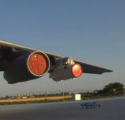An interesting image, which seems to suggest that Y-20 is being used as an engine test platform. I wonder what engine is being tested here.
View attachment 61353
At least it looks substantially slimmer/smaller than a regular D-30KP-2/WS-18

An interesting image, which seems to suggest that Y-20 is being used as an engine test platform. I wonder what engine is being tested here.
View attachment 61353

数控系统软件测试 sounds like it has to do with FADEC instead of CNC.CNC system software for the WS-15? From a November 2019 military contract tender
Progress in inverse problem design of multi-row blades of impeller machinery where engineering thermophysics is located
The design of impeller mechanical blades is generally divided into two methods: positive problem and inverse problem. The inverse problem design method can directly obtain the blade shape from the aerodynamic parameters on the blade surface, reducing the process of repeated iterative modification of the blade shape, and the design efficiency is higher. The dependence on the designer's experience is small, so it is of great significance to carry out the research on the design method of the impeller mechanical blade inverse problem.
The existing inverse problem design methods of impeller mechanical blades are mainly used for the optimization design of single-row blades, and the design research for extending it to multi-row blades is less, and the interaction and matching problems of dynamic and static blade rows are not considered. The Energy Storage R&D Center of the Institute of Engineering Thermophysics, Chinese Academy of Sciences has carried out research work on the three-dimensional inverse problem design method of impeller mechanical multi-row blades and made progress. The relevant research results have been published in .
The energy storage R&D center team assumes that the arc in the blade has a virtual moving speed. By introducing the characteristic line theory, the characteristic compatibility of the blade surface is used to couple the load on the blade surface to the virtual moving speed of the blade, and by studying the blade surface The characteristic of the boundary layer flow creatively proposes a method to limit the virtual displacement of each iteration step with the thickness of the viscous bottom layer (Y+<10) to ensure the stable and rapid convergence of the inverse problem design calculation process.
The research team further proposed a method to adjust the geometry of the inlet and outlet of the stator blades in real time according to the inlet and outlet airflow angles of the stator blades, which not only makes it easier to promote the inverse problem method to multiple rows of blades, but also effectively improves the matching effect of the dynamic and static blade rows . Using this method, the inverse problem optimization design of Stage35 transsonic compressor stage was carried out. The optimized moving blade load, static blade airflow angle and geometric angle are in good agreement with the target value, and the distribution is more reasonable, making the compressor stage The isentropic efficiency has been significantly improved over the entire operating range. This method has been applied in compressed air energy storage, gas turbine and aero engine design.
Related research is supported by the National Key R&D Program, the National Outstanding Youth Science Fund, the Chinese Academy of Sciences Frontier Science Key Research Project, the Chinese Academy of Sciences Clean Energy Strategic Leading Technology Project, and the 2019 Guizhou Basic Research Program.
Looks to be a core rather than a whole engine.
